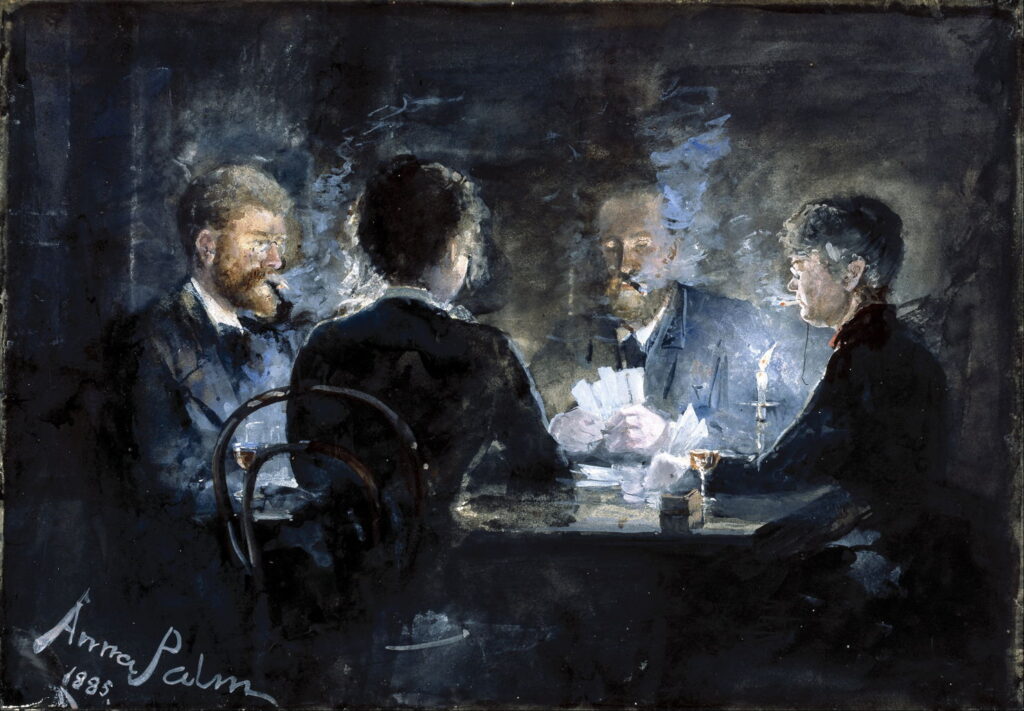In memoriam Anna Palm de Rosa: painting the card game

In the summer of 1885, the young Swedish painter Anna Palm visited the artist’s colony at Skagen in Denmark. One night she sketched two of the couples staying in the local hotel as they played cards by candlelight. There’s a silent tension as all four study their cards amid dense tobacco smoke. This article commemorates the death of Anna Palm a century ago today, on 2 May 1924.
Palm was born in an artistic family in Stockholm, Sweden, on Christmas Day 1859. Although her father taught at the school preparing students for the Royal Swedish Academy of Art, it was still unusual for women to attend the academy. During the early 1880s she was therefore taught independently by Edvard Perséus and Per Daniel Holm. For a couple of summers, she visited the colony at Skagen that was home to Nordic Impressionism.
Anna Palm de Rosa (1859-1924), A game of L’hombre in Brøndum’s Hotel (1885), media not known, 35.6 x 52.4 cm, Skagens Museum, Skagen, Denmark. Wikimedia Commons.
Her atmospheric painting of A game of L’hombre in Brøndum’s Hotel from 1885 shows a late-night session of this popular card-game between two couples staying at this hotel in Skagen, a remote fishing village at the northern tip of Jutland.
Palm exhibited at the academy in 1885 and 1887, and in 1889 started teaching watercolour painting there. During the early 1890s she specialised in panoramic watercolour views of Stockholm’s waterfront, and other Swedish landscapes, which became sufficiently popular to keep her brushes fully employed.
Anna Sofia Palm de Rosa (1859–1924), View with a Cliff (1891), watercolour, 47 x 75 cm, location not known. Wikimedia Commons.
This View with a Cliff from 1891 shows a section of the coast of the large Swedish island of Gotland in the Baltic Sea.
Anna Sofia Palm de Rosa (1859–1924), Panorama of Stockholm’s Royal Palace (1891), watercolour, 24.5 x 77 cm, location not known. Wikimedia Commons.
One of her many views of Sweden’s capital, Panorama of Stockholm’s Royal Palace from 1891 features the palace at its centre, with an interesting collection of steam vessels bustling about. She seems to have painted many similar views at this time.
Anna Sofia Palm de Rosa (1859–1924), Kalmarsund (date not known), watercolour, 23 x 68.5 cm, location not known. Wikimedia Commons.
Palm’s maritime view of Kalmarsund shows this strait between the southern Swedish mainland and the island of Öland. There’s an interesting range of small sailing ships and boats.
At the end of 1895 she travelled to Paris, where she painted watercolour views of the city. She also appears to have continued painting Stockholm using photographs, including some showing the 1897 Art and Industrial Exposition there.
Anna Sofia Palm de Rosa (1859–1924), Colosseum (c 1900), gouache on paper mounted on board, dimensions and location not known. Wikimedia Commons.
She painted this view of the Colosseum in Rome in about 1900, when she was visiting Italy. Then, in 1901, she married an Italian infantry officer, Alfredo de Rosa, and moved to live on the island of Capri.
Anna Sofia Palm de Rosa (1859–1924), Paris – Boulevard des Capucines (1903), watercolour, 43.5 x 74.5 cm, location not known. Wikimedia Commons.
She seems to have returned to France occasionally, where she painted Paris – Boulevard des Capucines in 1903. This is one of the Grands Boulevards of that city. In the right foreground is one of the men who posted notices such as those shown immediately above the car to the right.
Anna Sofia Palm de Rosa (1859–1924), Coach and Horses at Full Speed, Boulogne-sur-Seine (date not known), further information not known. Wikimedia Commons.
Her undated watercolour of a Coach and Horses at Full Speed, Boulogne-sur-Seine shows what’s now known as Boulogne-Billancourt, in the western suburbs of Paris, and not to be confused with the resort on the French channel coast.
In 1908, Anna Palm de Rosa settled with her husband near Naples. During his absence in the First World War, she’s reported to have painted prolifically. She died in Italy on 2 May 1924. For one moment she had perfectly captured that game of cards, in a painting that has gained fame only in the last decade.




